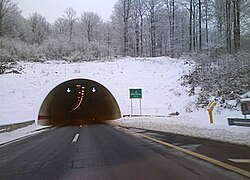Veliki Gložac Tunnel

Veliki Gložac Tunnel (Croatian: Tunel Veliki Gložac) is one of 13 tunnels found on the Croatian A6 motorway route. It is 1,126 metres (3,694 ft) long and consists of two tunnel tubes. It is located between Vrbovsko and Bosiljevo 2 interchanges. The tunnel is tolled within the A6 motorway closed toll collection system. There are no other toll plazas related to use of the tunnel. Construction of the tunnel was completed by Viadukt and Hidroelektra.[1][2]
European Tunnel Assessment Program (EuroTAP), a tunnel safety assessment program supported by the European Commission, coordinated by FIA and led by German motoring club ADAC, tested Veliki Gložac Tunnel in 2008, when it achieved very good results—ranking among the four safest road tunnels in Europe.[3]
Construction
Construction of Veliki Gložac Tunnel was started by Spie Batignolles and Mediteran Union Tunel.[4] The construction works contract was cancelled in 2001,[5] and the works were resumed by Viadukt and Hidroelektra in 2002 after a new contract was awarded to them. Similar timeline of events also went on in case of Javorova Kosa and Podvugleš tunnels.[6] The first, 1,115-metre (3,658 ft) tunnel tube of Veliki Gložac Tunnel was excavated by Spie Batignolles and Mediteran Union Tunnel on August 29, 2000,[7] while the second, somewhat longer, tube was excavated by Viadukt and Hidroelektra on November 25, 2005.[8]
Construction of the second tunnel tube was particularly complex due to proximity of the first tunnel tube excavated in five years earlier. Since axes of the two are merely 25 metres (82 ft) apart, and an oil pipeline runs nearby, blasting entailed special precautions. Since the first tunnel tube was already in use, traffic had to be suspended three times a day to allow progress of the works. Initial blast yield was lower and then gradually increased in order to achieve optimum results while maintaining safety. Finally, noise and oscillations of the first tunnel tube and the oil pipeline were constantly monitored to detect any sign of damage. Rock blasting started on June 9, 2005 and lasted until August 15, 2005, with more than 220 charges fired. At each of those times, traffic through the first tunnel tube was suspended for safety reasons.[8][9] The first tube of the tunnel, now carrying southbound traffic, is further characterized by the fact that it comprises three traffic lanes instead of standard two traffic lanes.[7]
Traffic volume
Traffic is regularly counted and reported by Autocesta Rijeka–Zagreb, operator of the A6 motorway and the tunnel, and published by Hrvatske ceste. Substantial variations between annual (AADT) and summer (ASDT) traffic volumes are attributed to the fact that the motorway carries substantial tourist traffic to Istria and Kvarner Gulf resorts. The traffic count is performed using analysis of toll ticket sales.[10]
| Veliki Gložac Tunnel traffic volume | ||||
| Road | Counting site | AADT | ASDT | Notes |
| 3022 Bosiljevo 2 west | 11,448 | 19,401 | Between Bosiljevo 2 and Vrbovsko interchanges. | |
See also
References
- ^ "Tuneli" (in Croatian). Hidroelektra. Retrieved October 10, 2010.
{{cite web}}: Unknown parameter|trans_title=ignored (|trans-title=suggested) (help) - ^ "Tunnel "Veliki Gložac" Rijeka-Zagreb highway". Viadukt. Retrieved October 10, 2010.
- ^ "Tunel Veliki Gložac među četiri najbolja u Europi". Poslovni dnevnik. April 23, 2008. Retrieved October 10, 2010.
{{cite news}}: Unknown parameter|trans_title=ignored (|trans-title=suggested) (help) - ^ "103. sjednica Vlade Republike Hrvatske" (in Croatian). Government of Croatia. July 26, 2001. Retrieved October 9, 2010.
{{cite web}}: Unknown parameter|trans_title=ignored (|trans-title=suggested) (help) - ^ "Spie Batignoles napustio tunele". Novi list (in Croatian). January 30, 2002. Retrieved October 10, 2010.
{{cite news}}: Unknown parameter|trans_title=ignored (|trans-title=suggested) (help) - ^ Mladen Jambrović (September 21, 2002). "Račan: Tunelom Javorova Kosa provozat ćemo se za Božić" (PDF). Vjesnik (in Croatian). Retrieved October 9, 2010.
{{cite news}}: Unknown parameter|trans_title=ignored (|trans-title=suggested) (help) - ^ a b Mladen Jambrović (August 30, 2000). "Probijen tunel Veliki Gložac na autocesti Rijeka - Zagreb". Vjesnik (in Croatian). Retrieved October 10, 2010.
{{cite news}}: Unknown parameter|trans_title=ignored (|trans-title=suggested) (help) - ^ a b "Danas proboj druge cijevi tunela Veliki Gložac" (in Croatian). Ministry of Sea, Transport and Infrastructure. November 25, 2005. Retrieved October 10, 2010.
{{cite web}}: Unknown parameter|trans_title=ignored (|trans-title=suggested) (help) - ^ "Izgradnja drugih cijevi tunela Čardak i Veliki Gložac" (PDF). HUKA Bilten (in Croatian) (5). HUKA. September 2005. Retrieved October 10, 2010.
{{cite journal}}: Unknown parameter|trans_title=ignored (|trans-title=suggested) (help) - ^ "Traffic counting on the roadways of Croatia in 2009 - digest" (PDF). Hrvatske Ceste. May 1, 2010. Retrieved October 5, 2010.
